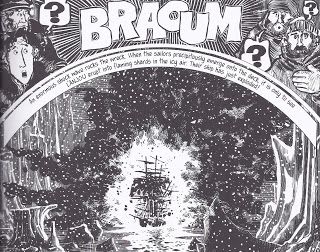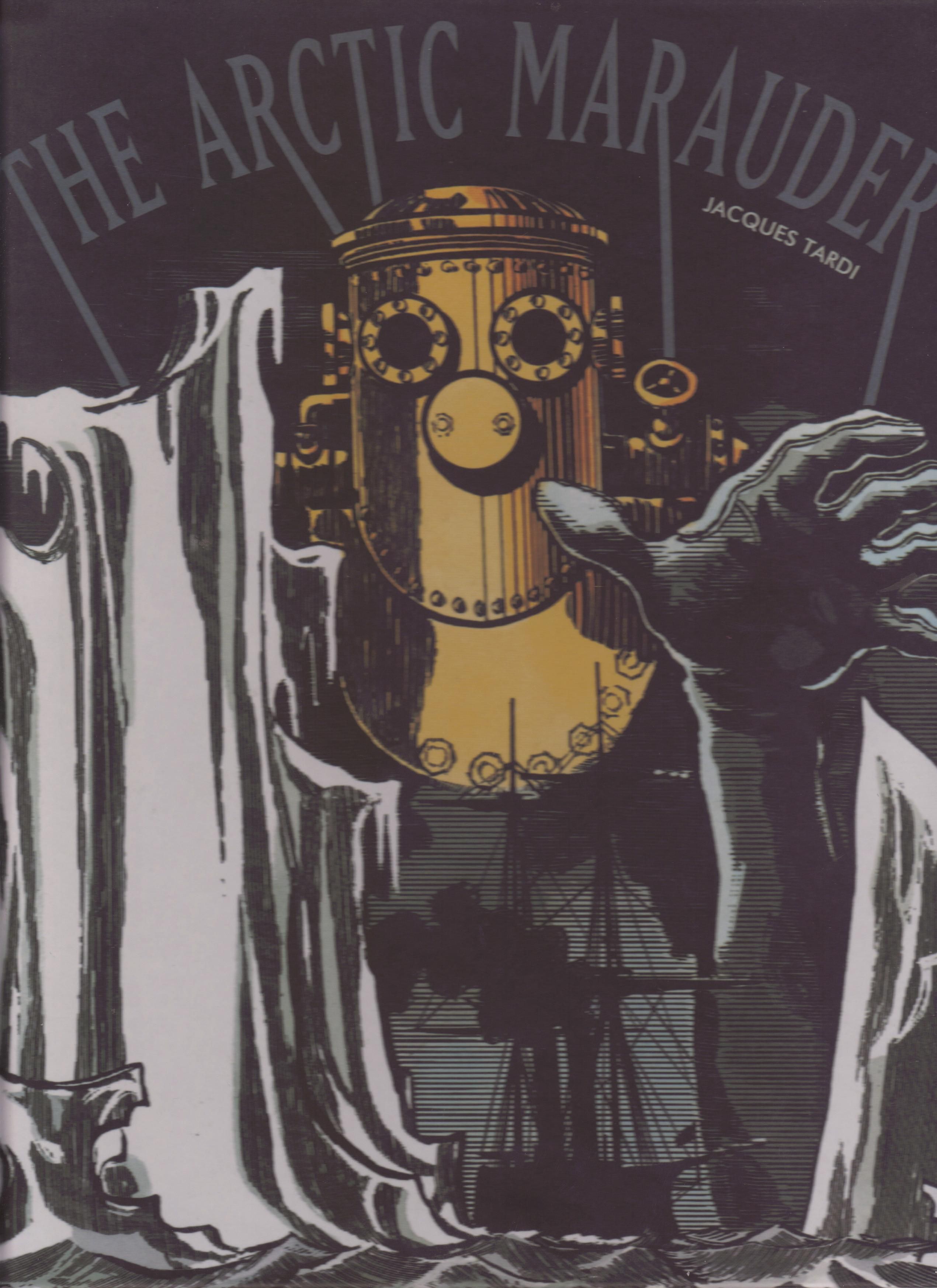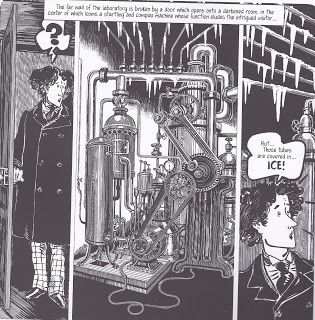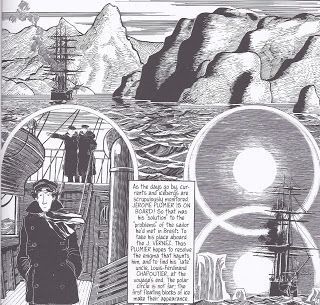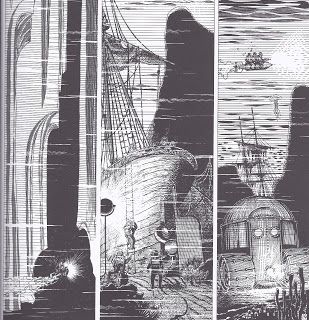Jacques Tardi is pretty awesome, y'all. But then, you already knew that.
The Arctic Marauder is the latest olde-tyme comic by Jacques Tardi that Fantagraphics seems committed to releasing. I have no problem with that, by the way.
This sucker is from 1974. Sadly, it looks more avant-garde and progressive than a lot of comics that are released today. It's a nice hardcover that costs $16.99 ... although it is only 63 pages long, so that might play into your decision to purchase it. Who can say?
I'd like to recommend The Arctic Marauder more emphatically, but I can't, even though I enjoyed and think you should give it a look. The big problem with the book is the writing, which I'll get to soon enough. As for the art, some of you may know that as I get older, I have started to appreciate artwork much more even though my vocabulary to describe is still poor (I'm working on it, I swear!), and for me, this book is all about the artwork. Tardi's line is as cartoony and even delicate as it is usually, but as this book is set in 1889 (unlike his other work that I've read, which are set in modern times or at least in the messiness of World War I), he changes the look of the art to reflect a more Victorian/fin de siècle sensibility, and I honestly don't know how he does it. The figures are drawn in a fairly standard way, but the surroundings look like woodcuts - I imagine he etched on a surface to get the effect, possibly something like Duo-Tone. This is why my vocabulary about artwork is poor, people! Some of the drawings look almost photo-referenced, but Tardi filtered them through Photoshop to get the effect, which I know was impossible in 1974, but that's how they look!
In addition to the nifty way the backgrounds are created, Tardi gives us magnificent details in the art.
The first brief part of the book takes place in the northern Atlantic, and Tardi's evocation of a ship at the mercy of the freezing cold is wonderful, as is the detail when his main character, Jérôme Plumier, joins part of the crew on an iceberg on which is frozen a ship. Tardi does a wonderful job building the suspense of what happened with the ship, showing the men climbing the iceberg (the ship is perched on top of a tall berg, a mystery easily explained) and climbing aboard a ghost vessel, where the crew has been strangely frozen. Later, when Jérôme discovers what is going on, Tardi turns into Jules Verne, showing the depths of the ocean with wonderful detail as Jérôme, his uncle, and his uncle's colleague zip around on a torpedo (that one can ride). Tardi also does a very nice job with the design of the pages - he doesn't stick with squares or rectangles, but uses many curved panels throughout the book - ovals and arches (some inverted) - to give each page a more unified look; it's not just panel-by-panel storytelling (although Tardi's storytelling is clear) but a single piece of art on many pages. The entire book is an absolutely gorgeous piece of artwork.
As I promised, though, the story doesn't quite hold up. The premise is perfectly fine, and indeed, the only real problem with the book is with the ending (well, there are some problems as Tardi goes along, but nothing too egregious).
Jérôme Plumier, a passenger on a steamship sailing from Murmansk to Le Havre in November 1889, joins a few crew members to investigate a ship trapped at the top of a tall iceberg. While the men are searching the ship, which is peopled by a crew that appears to have been flash-frozen, their own ship explodes and sinks. Jérôme and the others are rescued, and once back in Paris, Jérôme visits his uncle, Louis-Ferdinand Chapoutier, only to learn the old man passed away recently. His uncle was an odd sort of inventor, and he created a weird machine that somehow freezes everything around it. When he sees that an expedition is heading out to investigate the icebergs, he decides to join it (because that's what a young man of leisure did in 1889 Paris, apparently). He meets a strange old woman on the train, visits with one of the sailors who survived the initial journey, and gets to go on the expedition through some subterfuge. Of course, this ship explodes too. Jérôme is rescued from the sea by ... his uncle! Oh dear, something weird is going on.
After Jérôme wakes up in a comfortable bedroom, he learns that his uncle and an old scientist friend of his are planning on killing a whole bunch of people. Well, that's no fun. This is where the book becomes a bit off - the two men's scheme seems amorphous, Jérôme joins them without a second thought, and the plot speeds along from there. The ending is wildly unsatisfactory, providing absolutely no closure whatsoever - I don't know if there was a sequel to this, but it feels like Tardi was setting one up even if he had no interest in doing one.
It's not even that Jérôme joins his uncle's insidious plot - villains are pretty fun to read about, after all, and his uncle's friend is a perfectly fiendish one - but that Tardi doesn't really do much in the way of characterization, so Jérôme's abrupt decision to join the "dark side" seems to come out of left field. The book is almost pure plot, so when plot points aren't explained very well, the deficiencies in the book are highlighted. I have no issue with Jérôme joining the two older men in their scheme, partly because Jérôme is so much of a blank slate. But plot-wise, it's unexplained. The ending, as well, breaks down a bit because the plot speeds up so much. Tardi could have easily done ten extra pages and wrapped things up a bit better. Despite the feeling that this needs a sequel, it also feels as if Tardi stopped being interested in it and zipped through to the ending. It's a weird experience.
I can still recommend this because the plot is entertaining as far as it goes, and Tardi's art is so good. I do wish it had resolved a bit better, but you might not agree. Tardi isn't the greatest writer; he had different problems with It Was the War in the Trenches but they were still problems on the writing side. I don't know if he ever got any better. I suppose I'll have to wait for Fantagraphics to bring out more of his work!

